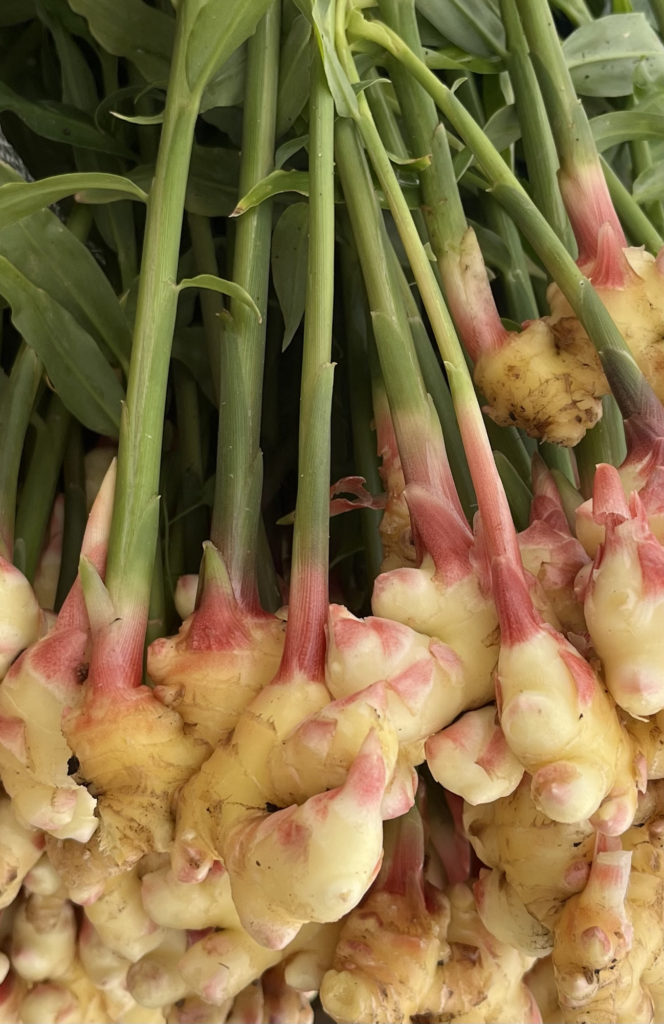A Rhinebeck Saffron Farmer

Green Owl Farm’s Suzanne Kelly grows specialty crops, including saffron, luffa and turmeric, and oversees Rhinebeck’s Natural Burial Ground
If you’ve perused the Rhinebeck Farmers Market, you’ve probably seen Suzanne Kelly and her booth of abundance. These days she’s got a variety of hard neck garlic (single bulbs, ½ pound bags, bulbs tied with dried herbs in bouquets, powder); saffron (threads, powder, extract, bitters, face oil); glistening baby ginger with vibrant green fronds; airy luffas; knobs of turmeric; black futsu squash, birdhouses made from gourds. Suzanne grows everything—including French melons, more squash, sunflowers, tomatoes, multi-hued fingerlings and carrots (There was a rainbow theme this year,” she says), in her Rhinebeck backyard, aka Green Owl Farm. The Certified Naturally Grown endeavor is barely an acre.
This time of year saffron, or crocus sativus, not commonly grown in this part of the world, is demanding a large part of her attention. Beginning with 3 rows of about 2500 corms (similar to bulbs) planted a few years ago, Suzanne has added to her saffron bed each year. In August, Dirty Gaia and a handful of volunteers helped her plant yet another 3 rows for a total of 10,000 corms. A quick grower, the crop bears its beautifully scented flowers through the first weeks of October.


Harvesting saffron is labor intensive. After the flowers are picked, their stigmas, which are the saffron threads, must promptly be removed by hand before they start to degrade. “Sometimes you have to stay up all night,” Suzanne says. “There’s a total dedication to getting it done.” No surprise, then, that saffron has long laid claim to being the world’s most expensive spice. Once separated, the stigmas, generally three per flower and weighing just a fraction of an ounce, are laid on dehydration trays. After they’ve dried, the threads are either placed in diminutive Green Owl Farm wood-top jars or saved to make powder, extract and other products. The petals are used to create a skin-softening foot bath. “Just trying to make it all turn into something,” Suzanne says.

Before turning to farming, she had a career in academia. “I was teaching Womens Studies at SUNY New Paltz for a little over ten years. I love the classroom and the movement of ideas and the students. But the [administration] demands more and more of you that doesn’t have anything to do with the classroom. It was a lot of drudgery.” When she quit, she made her already large garden a lot larger.
But still, an acre has limits. “I’m always looking for high value crops, because I only have so much land,” she says. “And I’m always looking for things I can handle myself in stages, that I don’t need to get to market right away, like garlic and saffron. Potatoes are ready in the middle of August but I don’t have to harvest them until two months later.” Taking advantage of the commercial kitchen at her sister’s home in Staatsburg, she developed the powders, oils, bitters and extracts, adding to the value of what she pulls from the earth and the interest of her farmers market stand.


As she began growing in earnest, Suzanne also delved deeper into her role as a green burial advocate, an issue she became interested in when her father died in 2002. Green burials forego embalming, coffins, and other extraneous materials that compromise the environment and foster the idea that the body is a contaminant. Friends and family are encouraged to join in the death and funeral process, reflecting the customs of earlier generations. Suzanne’s book, Greening Death, Reclaiming Burial Practices and Restoring Our Ties to the Earth details the history of our approach to death and burials and its evolution.
“In 2009 or 10, I heard rumblings that the town [of Rhinebeck] was going to do something about green death,” she says. “So I thought I’d get on the committee.” She recalls the initial reaction of the older-all-male advisory board as “Who is she and why is she here?” But says it soon became, “We’re going to make you chair!” Rhinebeck’s Natural Burial Ground, in a hardwood forest adjacent to Grasmere Cemetary, opened in 2014 and Suzanne is the Administrator.

The roughly 10-acre site is certified by the Green Burial Council, a distinction similar to the LEEDS certification awarded green architectural projects. “It’s the most diverse place in Rhinebeck class-wise, racially, religiously,” she says. “We’ve had so many different kinds of services. We had a 7-piece mariachi band playing in there for an hour and a half, and the next burial was in Korean. These rituals are totally remaking the woods.”
Green burials usually take much longer than traditional funerals because there’s more participation from friends and family. “We have a hand-drawn cart,” Suzanne says, “and there’s a procession from the parking lot into the woods. People take on rituals, they lower the body into the grave with straps, they fill the grave. It’s very meaningful to the families.” Some of the deceased are buried in their own blankets, some in woven willow caskets. “It’s been amazing,” Suzanne says. “It’s municipal and a great model; it’s for everybody. The fact that the town board makes decisions about it just warms my heart. It’s one of the few things we all agree on.”
During the winter, Suzanne will continue to manage her online farmstand, and consider new additions to her product line. “I’ve been thinking about saffron-infused honey,” she says. Follow her @greenowlgrower for updates.
—Margot Dougherty
